With more than 4,000 colleges and universities in the United States, students can become overwhelmed with the college admissions process. As an institution, your goal is to streamline this process, showing a clear path for your prospective students and helping their decision-making.
Herein lies the power of the enrollment funnel—a systematic approach that breaks down the student’s journey from initial awareness to final enrollment.
In this article, we’ll review the enrollment funnel and uncover strategies for every enrollment funnel stage to help you spread awareness and increase student admissions for your institution.
📑 Table of Contents
What is the Enrollment Marketing/Admissions Funnel?
The enrollment marketing or admissions funnel is a metaphor used by educational institutions to visualize and understand the journey of a prospective student from the initial point of awareness about the institution to the final stage of enrollment.
It helps schools, colleges, and universities design strategic marketing and communication tactics at each phase.
The Enrollment Marketing Funnel: Breaking It Down
The enrollment marketing funnel is modeled after the sales funnel, with six stages:
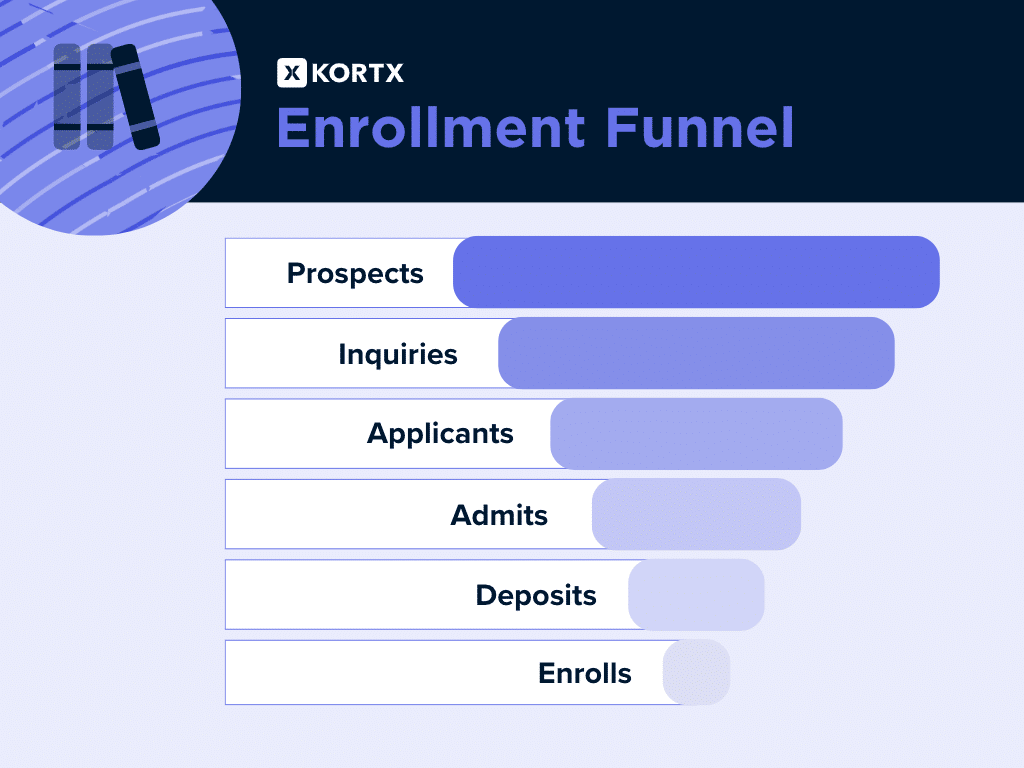
- Prospects: Individuals interested in attending a particular institution or program. They might have shown interest by attending a college fair, visiting a website, or engaging in an open house event.
- Inquiries: These are prospects who have taken a step further to actively inquire about the institution or program, either by filling out a form, requesting information, or getting in touch directly.
- Applicants: Individuals who have decided to apply to the institution or program formally.
- Decision or Admits: Those admitted or accepted into the institution or program after the application review.
- Deposits: Admitted students who have put down an enrollment deposit indicating their intent to enroll.
- Enrolls: The final stage, where the individuals actually enroll and begin their journey at the institution or program.
Each stage fits into a three-stage funnel model:
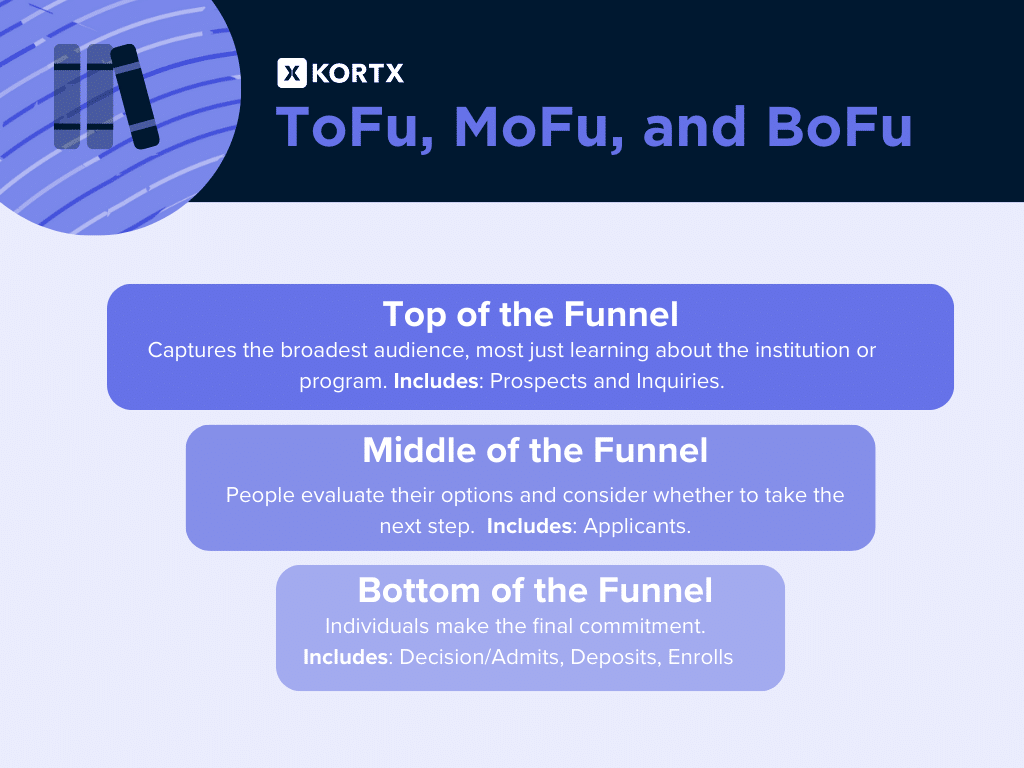
1. Top of the Funnel (ToFu)–Awareness or Discovery phase: It captures the broadest audience, most just learning about the institution or program.
▶️ Includes: Prospects, Inquiries
2. Middle of the Funnel (MoFu)–Consideration phase: People evaluate their options and consider whether to take the next step.
▶️ Includes: Applicants
3. Bottom of the Funnel (BoFu)–Decision or Action phase: Individuals make the final commitment.
▶️ Includes: Decision or Admits, Deposits, Enrolls
Using the funnel to visualize this, the wide top captures all prospects and inquiries. As you descend, it narrows with fewer applicants and those admitted, and ultimately, the students who enroll at the bottom. This helps institutions strategize how to move students from one stage to the next.
Optimization Strategies For Every Stage of The Enrollment Funnel for Maximum Success
Each stage presents unique challenges and opportunities, requiring tailored approaches for optimal results. Understanding the needs and motivations at every stage can help you craft strategies that drive desired outcomes.
Though some strategies seem similar, their specific roles vary based on where they fit within the funnel. For example, at the top of the funnel, Meta ads should start with the goal of reaching a wider audience to attract as many eyeballs as possible but shift to conversion objectives at the bottom once you’ve found your most qualified prospects.
Top of the Funnel (ToFu) Tactics: Awareness
At this initial stage, the goal is to capture the attention of as many potential students or parents as possible.
1. Meta Ads
Goals: Reach, Video Views
Meta ads in this stage cast a wide net, specifically aimed at parents. Ads should target broad objectives like maximizing reach (the total number of unique users who see the ad) and increasing video views, which are key metrics to gauge the success of video content and its resonance with audiences.
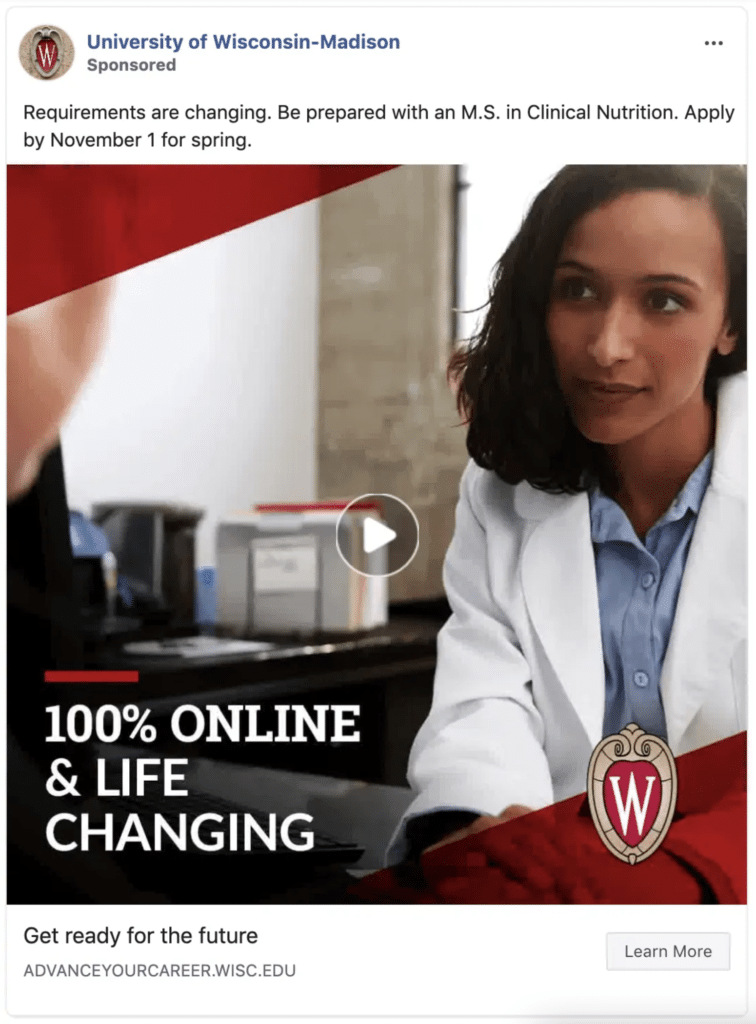
In this Meta ad, the University of Wisconsin-Madison is helping prospective students and parents understand what their university offers.
2. CTV (Connected TV) Ads
KPIs: Reach, Video Views
Ads on CTV platforms (like Roku or Apple TV) cater to viewers who’ve shifted from traditional broadcasting to streaming services. These platforms offer tailored ad experiences, allowing brands to showcase compelling visuals and narratives, ideally capturing the attention of a tech-savvy audience during their leisure time.
THIS IS THE BEGINNING Fall ’23 CTV AD (30 second version) from Bethel University on Vimeo.
Bethel University, a private Christian University, uses a CTV ad to target students on their journey to find their college. This ad could work for each funnel stage as it touches on awareness, consideration, and making a decision.
What is one strategy you recommend to attract top-of-the-funnel leads in the awareness stage?
“Interactivity is key! Prospective students will remember emails, texts, and websites that offer more interactive and immersive experiences. Keep emails, websites, and digital optimized for mobile and consider new channels like Reddit to expand your digital reach.”

Interactive Connected TV (CTV) ads can be highly effective in enrollment marketing for prospective students. Traditional TV spots are a passive ad experience.
With interactive CTV ads, viewers (including parents and students) can click on the ad for more information or even schedule a campus visit. They also add that immersive experience Shaun D. Keating from 3 Enrollment Marketing speaks to.
📚 Learn more about CTV Advertising:
3. TikTok Ads
Goals: Reach, Video Views
TikTok’s rise as a social media powerhouse provides a unique platform to target younger audiences. Like Meta, the primary ToFu objectives are maximizing reach and increasing video views. With its short, dynamic, and engaging video format, TikTok is perfectly suited for institutions aiming to make a quick but memorable impression.
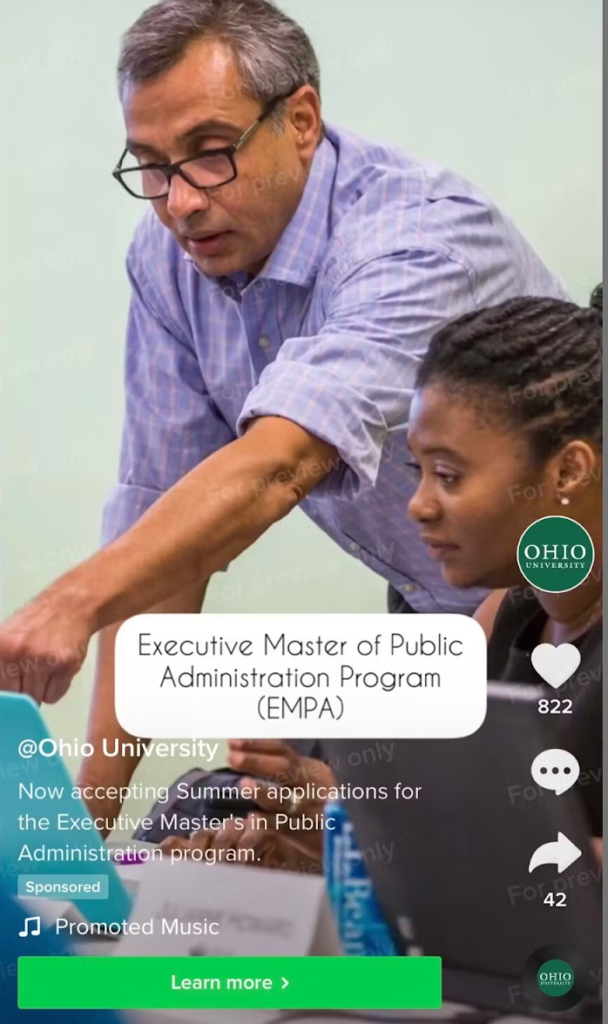
Ohio University used TikTok’s in-app ad campaign feature to increase enrollment for their Executive Master’s in Public Administration degree. Their campaign targeted full and part-time employees looking to get an EMPA.
4. Display Ads
Goal: Click-Through Rates (CTR)
Display ads on websites and apps primarily focus on visuals to attract user attention. The success of these ads at the ToFu stage is often measured by the Click-Through Rate (CTR), which indicates the percentage of users who clicked on the ad after seeing it. A high CTR suggests that the ad is not only garnering attention but also compelling enough to encourage user interaction.
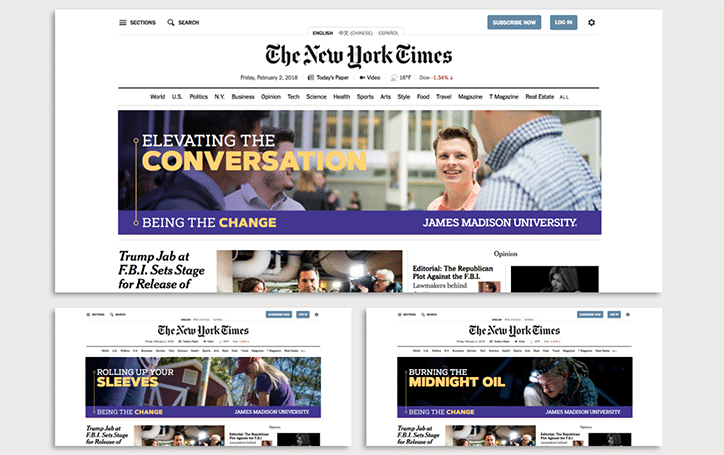
James Madison University used these display ads to target parents reading the New York Times.
5. Online Video
Goal: Video Completion Rate (VCR)
By the time a prospect reaches the lower funnel, they’ve likely encountered a brand or product several times. Online video ads can reinforce a message, reiterating the value proposition in a visually engaging way.
A well-crafted video can create a sense of aspiration, urgency, or even a fear of missing out (FOMO). And they’re also excellent tools for retargeting campaigns. If someone visited an enrollment page but didn’t sign up, a retargeted video ad could remind them of what they’re missing out on, pushing them through the enrollment funnel.
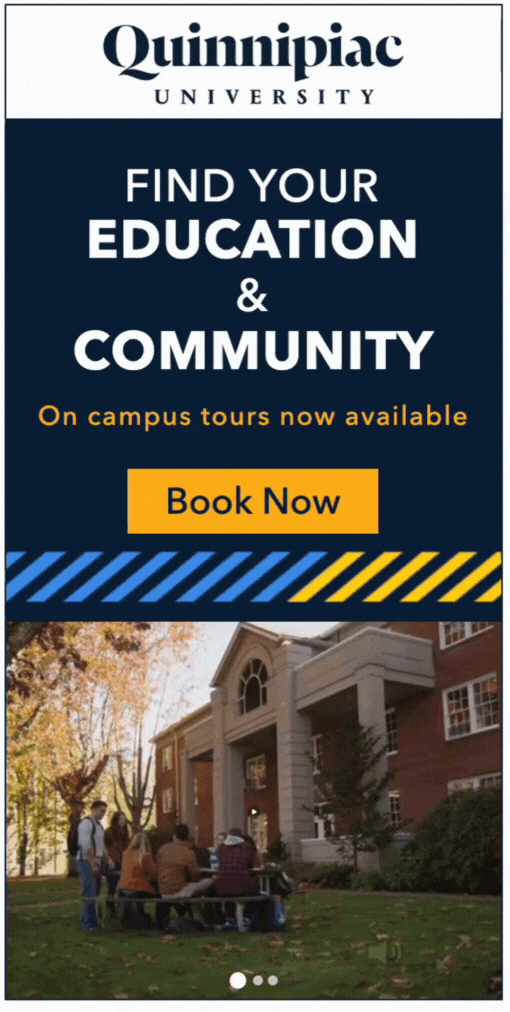
Quinnipiac University and KORTX partnered to run this online video ad targeted to lower-funnel and mid-funnel prospects considering the university.
🔍 Case Study: Gen Z College Admissions Marketing: 6,000+ Applications: Learn how Quinnipiac University and KORTX transformed recruitment strategies and exceeded application expectations.
6. Influencer Marketing
Goal: Generate awareness
Engaging with influencers is a great ToFu tactic. Influencers bring authenticity and trust, especially among younger audiences. Collaborations, shout-outs, or product placements within influencer content can amplify a brand’s visibility and create an organic sense of awareness and interest.
Thompson Rivers University recruited an alumna to showcase their student life services. She then shares these videos to her personal social media accounts for additional reach among her followers.
What can make influencer marketing difficult for enrollment marketers?
“One of the challenges is finding the right influencer who aligns with the brand and ethos of a university. Ideally, an influencer should have some authentic connection to the institution, perhaps as an alumni. This lends credibility to their endorsement, making it more impactful. For example, if a celebrity is promoting Ohio State University, viewers would ideally see that the celebrity is an alumni. Without that authentic connection, the marketing message could feel disjointed or even disingenuous.”

Middle of the Funnel (MoFu) Tactics: Consideration
This middle of the funnel (MoFu) stage is where prospective students and parents weigh their options, gather more information, and start forming a connection with specific institutions.
Here, we explore several MoFu tactics to foster this engagement and consideration.
1. Paid Search
Goal: Generate awareness
Paid search platforms like Google Ads display your advertisements when specific keywords related to your offerings are searched. It directly responds to the user’s expressed interest, offering them the exact information or solution they’re seeking, thus bolstering consideration.
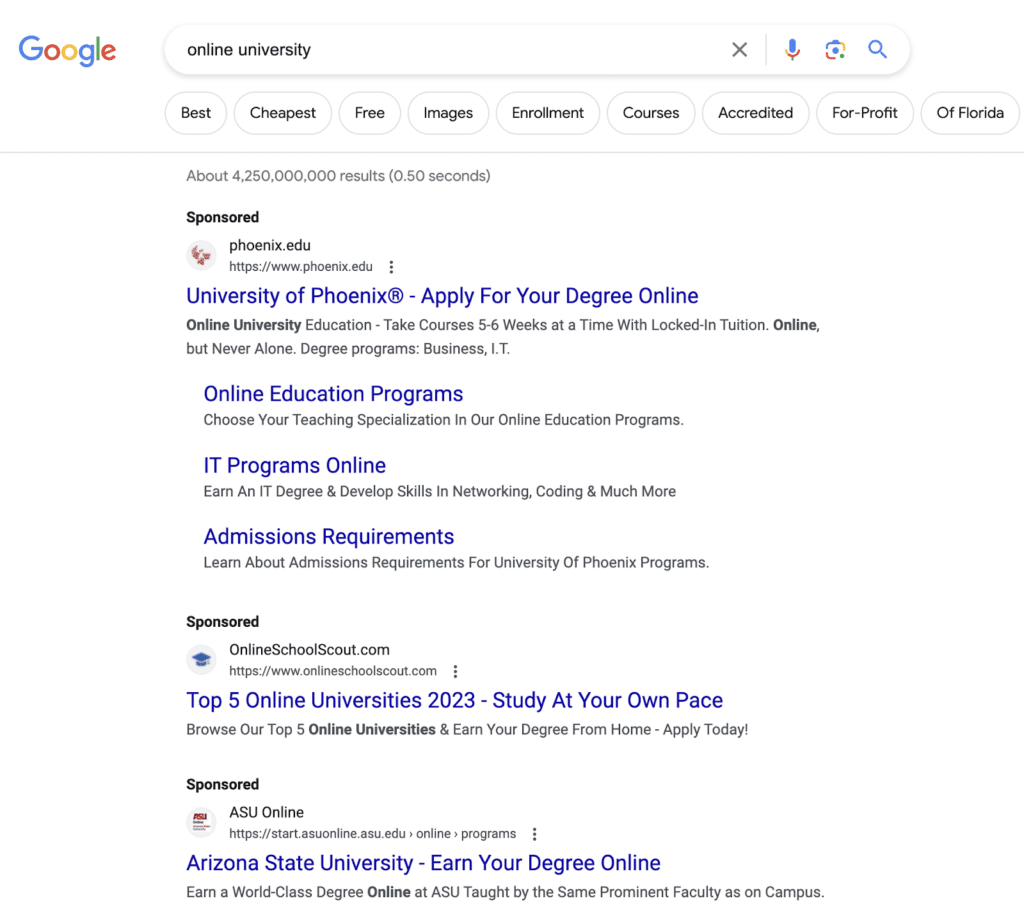
Those seeking an online university might see these ads for the University of Phoenix, making it top of mind during their decision process.
2. Meta Ads
Goal: Traffic
In the MoFu stage, Meta Ads shift from broad-reach objectives to driving traffic. The goal is to get users to click the advertisement and land on a specific webpage to research deeper into offerings, products, or services. Measuring the traffic generated from these ads can help brands gauge interest levels and refine their approach for better engagement.
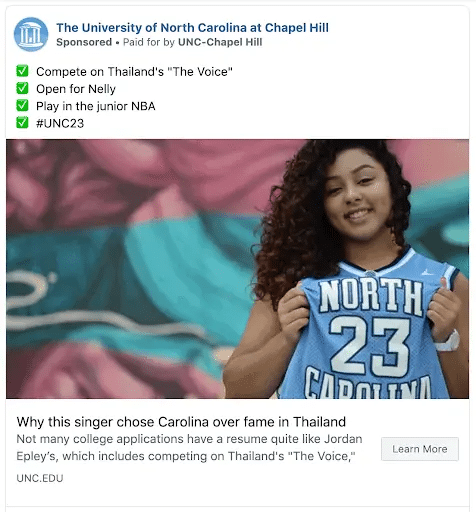
The University of North Carolina mixes both Meta and influencer marketing by showcasing an interview from their famous alumna for those considering their institution.
3. TikTok
Goal: Traffic
With its visually compelling format, TikTok remains a strong contender in the MoFu stage. Here, ads focus on driving users to external sites or specific pages within the TikTok platform. The aim is to provide more detailed content, product showcases, or narratives that pique interest and draw users into the consideration phase.

During June, Wayne State University offered a variety of consideration-focused TikToks, like this campus tour, to entice prospective students as they make their university decisions.
4. Custom Rich Media
Goal: Engagement Rate
Custom Rich Media ads are interactive display ads that offer a richer, more engaging user experience. These ads command attention whether through animations, embedded videos, or interactive elements. At the MoFu stage, their success is often measured by the engagement rate, reflecting how interactively users engage with the content.
5. Cross-Platform Display
Goal: Site Traffic
As the name suggests, Cross-Platform Display ads appear across multiple devices and platforms. With Cross-Device Targeting, you can target multiple audiences within the same households. For example, you can target a CTV ad on smart TVs for parents and target a different message to prospective students in the household on mobile devices.
Targeting across several devices ensures that you send the right message to the right audience at the right time, nudging your prospects further down the funnel.
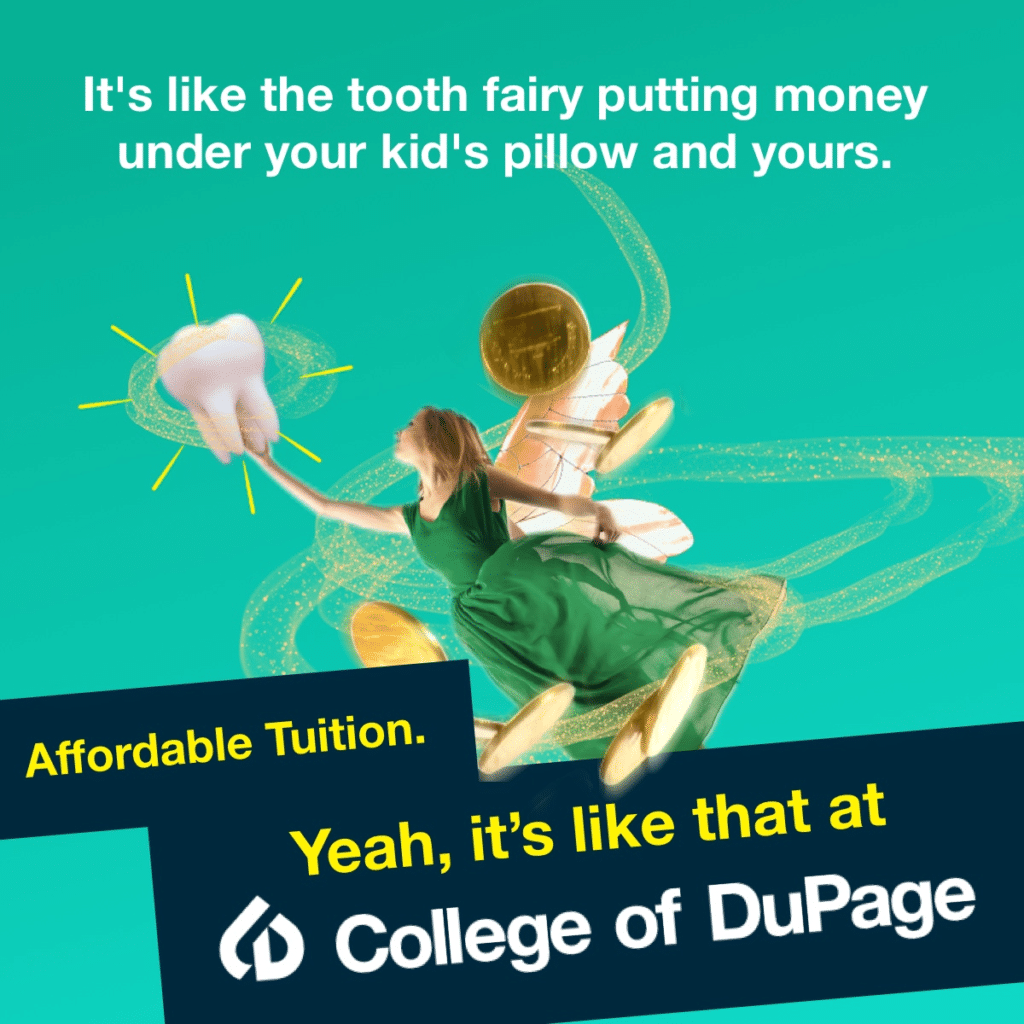
The College of DuPage targeted parents in this ad, enticing them with low tuition rates. With Cross-Device Targeting, DuPage can send this to devices parents use in the household.
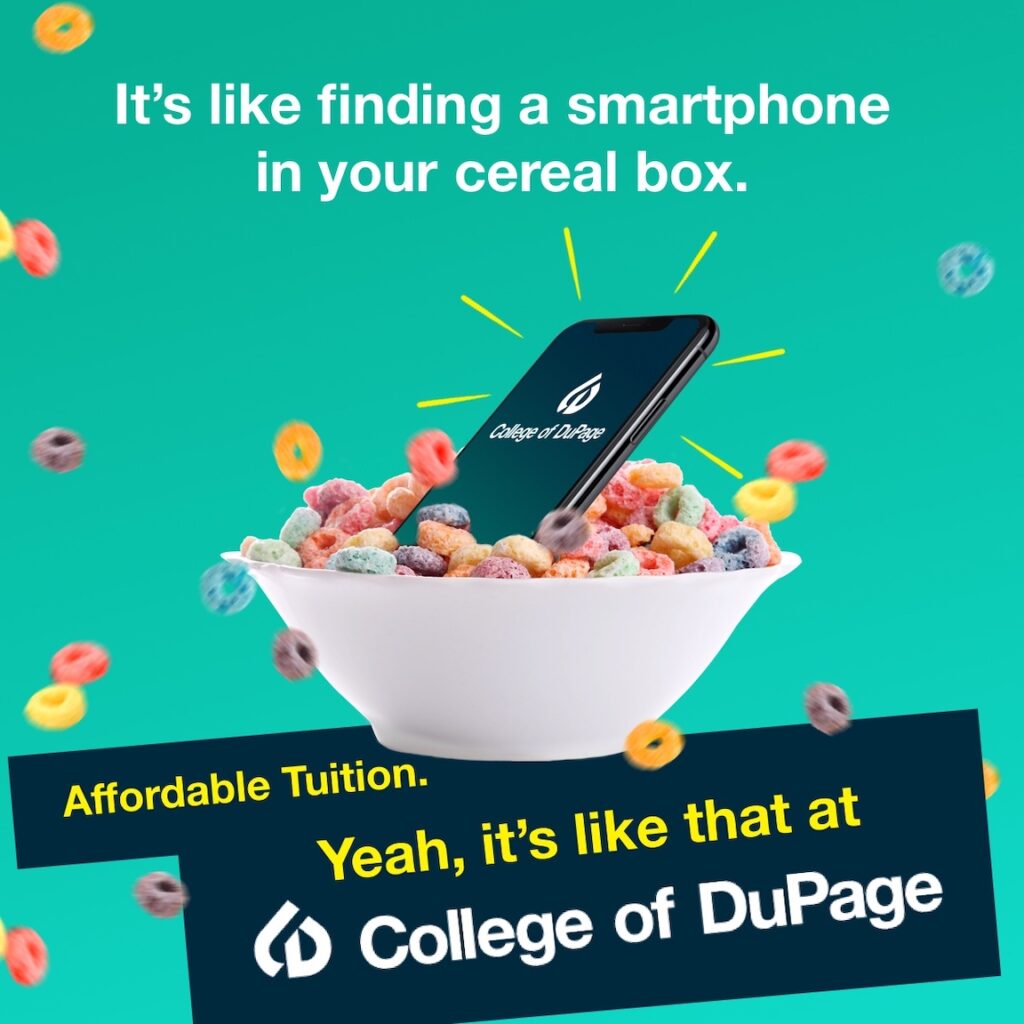
This DuPage ad uses visuals and copy targeted to Gen Z, “like finding a smartphone in your cereal box.” DuPage can send this ad to devices in the household used by prospective students.
6. Influencer Marketing
Goal: Generate awareness
While influencers play a significant role in generating initial awareness, their power doesn’t wane in the MoFu stage. Influencers can look more in-depth into their experience at your school. Their trusted voice can sway followers, nudging them closer to a decision.
How can universities find the right influencers to help market their program?
“Use the influence of alumni who have gained some level of fame or social media following. This offers a dual advantage: the influencer has a natural, authentic connection to the university, and they are more likely to accept a lower fee or even volunteer their time for an institution that has contributed to their success. For example, imagine if a well-known musician who received an honorary doctorate from a university were to endorse that institution. It would not only add star power but also a layer of authenticity that resonates with prospective students.”

Bottom of the Funnel (BoFu) Tactics: Decision
When prospects reach the bottom of the funnel (BoFu), they’re on the cusp of making a decision. This stage is characterized by a stronger intent to take action, be it purchasing, enrolling, or subscribing.
So, the tactics employed in the BoFu need to be more targeted, aiming to seal the deal.
1. Paid Search
Goal: Conversions
In the decision phase, Paid Search continues to be instrumental. These ads now respond to highly specific, intent-rich search queries, offering prospects the final push they might need. A searcher using specific program names or detailed program descriptions is likely close to making a decision, and the ad can be the bridge to their final action.
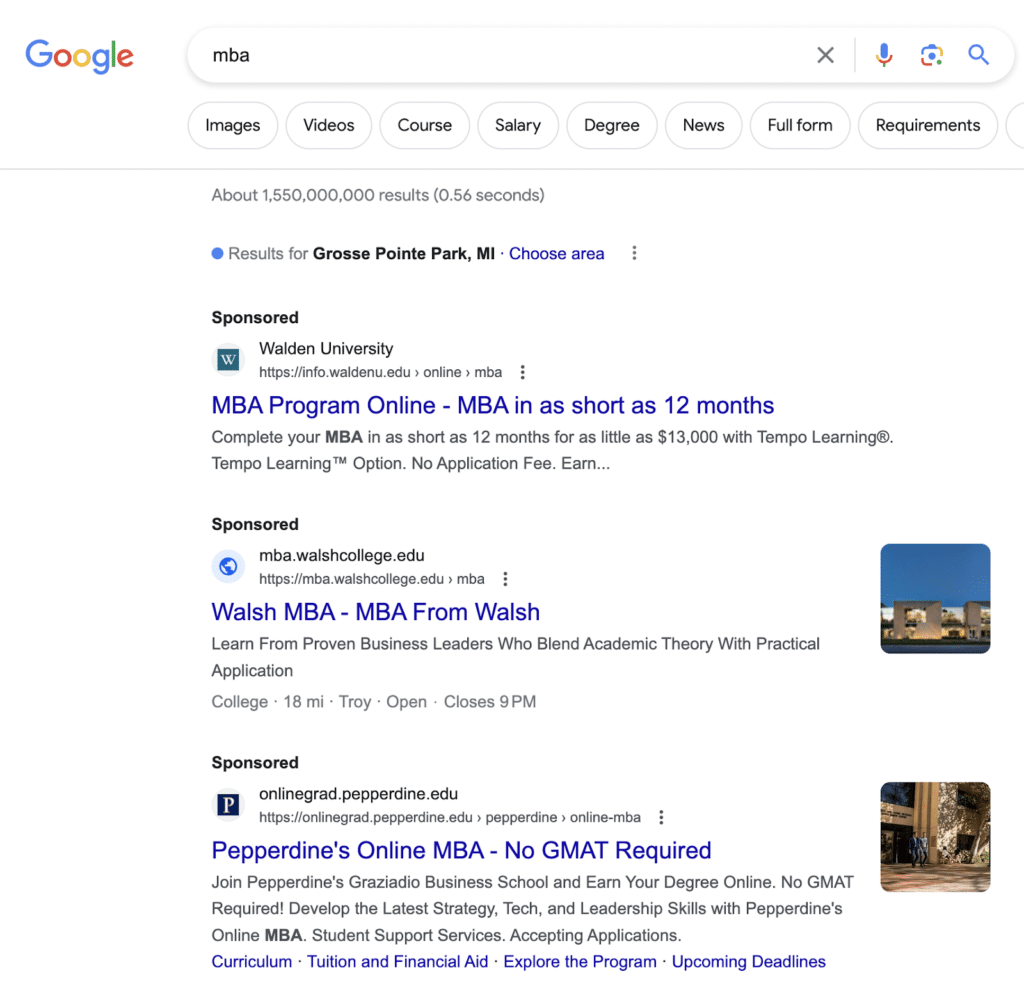
2. Meta Ads
Goal: Conversions
Here, the objective of Meta Ads is laser-focused on conversions. Whether it’s signing up for a newsletter, downloading an app, or submitting a form, these ads aim to drive tangible actions. The beauty of Meta Ads at this stage is their flexibility; conversions can range from app downloads to form submissions or any other web activity that’s deemed valuable. A common use case is driving application submissions for educational institutions or job portals.
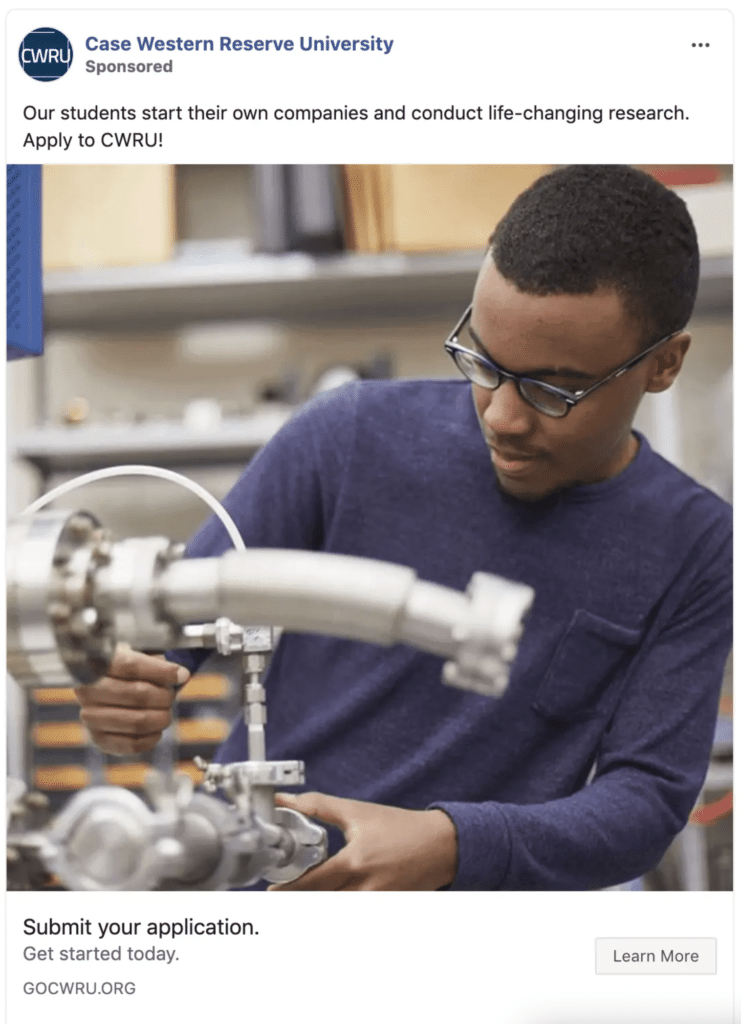
Case Western Reserve University targeted student prospects ready to apply to the institution.
3. TikTok
Goal: Conversions
By the BoFu stage, TikTok ads take on a more urgent tone. Leveraging the platform’s vast visual capabilities, these ads can showcase campus life, narrate alumni success stories, or show off programs geared towards driving a conversion.
@uofmichigan The results are in! Michigan Medical School students celebrated Match Day today and found out where they will be starting their residencies ✉️ #UofM #UMich #Michigan #MedicalSchool #MatchDay #GoBlueMatch #CollegeLife ♬ original sound – University of Michigan
The University of Michigan (UofM) highlighted its Medical School’s Match Day event, where students find out where they’ll do their residency. Those considering the med school might feel motivated to apply, knowing that UofM cares about their next steps post-college.
4. Influencer Marketing
Goal: Conversions
The influencer marketing strategy in the BoFu stage is more adaptable. They might present detailed stories of their experience at your university through social media or an interview with your staff to feature on your blog and social media. The goal is to use the influencer’s credibility and reach to encourage a conversion.
5. Cross-Platform Display
Goal: Conversions
Consistency remains the hallmark of Cross-Platform Display ads. As prospects move devices or jump between platforms, these ads offer a consistent, compelling message. In the BoFu stage, the call to action in these ads must urge prospective students to convert.

Targeting potential students interested in DuPage, this ad showcases a vibrant scene: a young student studying outdoors on the lush campus lawn. DuPage can target students with this ad across multiple devices, encouraging them to complete an application, ultimately converting.
📚 Related Article: 13 Innovative Higher Education Marketing Trends in 2023: Uncover the latest trends in higher education marketing and discover actionable strategies to boost your institution’s enrollment.
Enrollment Funnel Marketing: Success for the Future
Institutions must adapt their strategies to address prospective students’ needs, guiding them toward enrollment. With changing demographics and evolving expectations, regular refinement of this funnel is essential. By staying attuned to student needs and using data-driven insights, institutions can remain competitive and relevant in the dynamic landscape of higher education.
Drive Enrollees With Our Enrollment Marketing Services.
As an enrollment marketing agency, we’ll use data and our expert strategies to connect you with the prospects most likely to enroll in your university, driving success for years to come.
Josh Pheneger is an Account Strategist at KORTX. He likes to play golf, explore the city, and spend time in coffee shops.
